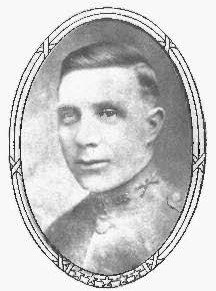Hero Bio:
Roy Melvin Smyth was born at Carters, Tuolumne County, California, March 21st, 1890. He attended school there, graduating at the age of fourteen, and entered the Oakland High School. The Smyth family moved to Nevada and settled at Seven Troughs in Humboldt County where they now live. Having graduated from high school, the boy, Roy, entered the University of California, but during his Freshman year he received the appointment to West Point from the late Senator Newlands, March 1st, 1910. The West Point course was completed in 1914, and he was attached to the 4th Infantry Regiment, then at Vera Cruz, Mexico, as a Second Lieutenant. Afterwards the regiment was stationed at Galveston, Texas, at Brownsville, where he was promoted to a First Lieutenancy, and at Gettysburg, Pennsylvania, where he was again promoted to Captaincy. He was also made Regimental Quartermaster, which post he held until the regiment went to France. When the war broke out the 4th went to Camp Greene, North Carolina, then to Camp Stuart at Newport News, and from this point embarked for France, April 6th, 1918, on the S. S. Great Northern.
When the 4th Infantry went to the front with the 3d Division, the 1st Battalion was commanded by Major Roy Smyth, who in the meantime had received another promotion. The division served through the desperate battle of the Second Marne from May 31st to July 29th before being withdrawn from the line. In September they entered the Meuse-Argonne country and by the 29th had relieved the 79th Division west of Nantillois. They fought their way northward, consolidating their positions and preparing for a great general offensive. This occurred on October 14th. At that time there were over 1,000,000 American troops in the line which extended over a length of 120 kilometers. The 3d Division had cleared the Bois de Foret and were on the heights above the Meuse River when the 5th Division relieved them on the 27th. But in the meantime (October 15th, 1918) Major Smyth had fallen in the battle-line west of the Bois de Foret.
At the time of his death, his men were falling from snipers’ bullets. The Major procured a rifle and joined the men in picking off the snipers. At this moment Colonel Dorey appeared, and while the Major was pointing out to him the location of a sniper, a bullet struck him in the head, killing him instantly.
Major Smyth was buried in the American Cemetery at Madalino Farms, France. As an officer he had been one of those who looked first to the comfort and safety of his men and afterwards to his own. His military record is a credit to the Nation he so valiantly served and to the State of Nevada which has lost a gallant son. He won the Distinguished Service Cross early in the fighting (June 23, 1918), and at the time of his death his commission as a Lieutenant-Colonel had been approved but not yet received.
He is survived by his parents, Hugh N. and Annie M. Smyth of Seven Troughs, Nevada; two brothers, William Smyth of Packard, Nevada, and Hugh Smyth of Alameda, California; and two sisters, Lois of Reno, and Clara of Alameda.
Rank in Death:
Major 1st
Regiment, Brigade, Division in Death
Battalion 4th Infantry 3d Division
